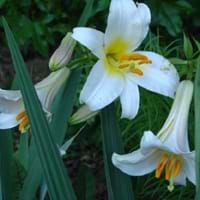Life Span
Perennial
Perennial
Type
Flowering Plants
Bulb or Corm or Tuber
Origin
Italy, Southern Europe, western Balkans
Hybrid origin, North America, Europe, Africa, Asia
Types
not available
White lily, orange lily, Lily of the valley
Habitat
Islands, Not Available
Not Available
USDA Hardiness Zone
7-10
2-8
Habit
Upright/Erect
Upright/Erect
Flower Color
Lavender, Light Blue, White
White, Yellow, Red, Green, Purple, Gold, Pink, Rose, Peach, Burgundy, Bronze
Flower Color Modifier
Bicolor
Bicolor
Fruit Color
Non Fruiting Plant
Yellow green, Sandy Brown
Leaf Color in Spring
Green, Light Green
Green, Dark Green
Leaf Color in Summer
Green, Light Green
Light Green
Leaf Color in Fall
Green, Light Green
Several shades of Green
Leaf Color in Winter
Light Green
Light Green
Leaf Shape
Compound
Long Linear
Plant Season
Summer, Fall
Spring, Summer, Fall
Sunlight
Full Sun, Partial Sun
Full Sun, Partial Sun, Partial shade
Growth Rate
Medium
Medium
Type of Soil
Loam
Clay, Loam, Sand
The pH of Soil
Acidic, Neutral
Acidic, Neutral, Alkaline
Soil Drainage
Average
Well drained
Bloom Time
Early Summer, Summer, Late Summer
Not Available
Tolerances
Heat Tolerance
Drought
Where to Plant?
Ground, Pot
Container, Ground, Pot
How to Plant?
From bulbs, Seedlings, Stem Planting
From bulbs, Seedlings, Seperation
Plant Maintenance
Low
Medium
Watering Requirements
Average Water Needs, Do Not over Water, Never Over-water, Requires regular watering
Do Not over Water
In Summer
Lots of watering
Lots of watering
In Spring
Moderate
Moderate
In Winter
Average Water
Average Water
Soil pH
Acidic, Neutral
Acidic, Neutral, Alkaline
Soil Type
Loam
Clay, Loam, Sand
Soil Drainage Capacity
Average
Well drained
Sun Exposure
Full Sun, Partial Sun
Full Sun, Partial Sun, Partial shade
Pruning
Remove damaged leaves, Remove dead branches, Remove dead leaves, Remove dead or diseased plant parts
Prune in early spring, Prune in fall, Remove dead or diseased plant parts
Fertilizers
fertilize every 2-3 weeks while growing, fertilize in growing season
Compost, Fertilize only when soil is poor, Organic Flower Fertilizer
Pests and Diseases
fungus
Aphids, Lily Beetle, Stem canker
Plant Tolerance
Drought, Heat Tolerance
Drought
Flower Petal Number
Single
Single
Showy Foliage
Not Available
No
Foliage Texture
Not Available
Not Available
Foliage Sheen
Not Available
Not Available
Attracts
Birds, Insects
Birds, Hummingbirds, Not Available, Snails
Allergy
Toxic
Mild Allergen, Not Available, sneezing
Aesthetic Uses
Beautification, Landscape Designing, Showy Purposes
Beautification, Showy Purposes
Beauty Benefits
Not Available
Making cosmetics
Environmental Uses
Air purification
Fixes Nitrogen, Indoor Air Purification
Medicinal Uses
Asthma, Cough, Unknown
Burns, Diuretic, Heart problems
Part of Plant Used
Flowers, Leaves
Whole plant
Other Uses
Decoration Purposes, Showy Purposes, Used as Ornamental plant
Application in Handicrafts, Basketary, Cosmetics, Oil is used for aromatherapy, Oil is used in mosquito repellents, Used as Ornamental plant, Used for its medicinal properties
Used As Indoor Plant
Yes
Yes
Used As Outdoor Plant
Yes
Yes
Garden Design
Mixed Border, Wildflower
Alpine, Container, Cutflower, Feature Plant, Mixed Border, Wildflower
Botanical Name
CAMPANULA pyramidalis
LILIUM
Common Name
Chimney Bellflower
Lily
In Hindi
Chimney Bellflower
लिली
In German
Schornstein Glockenblume
Lilie
In French
cheminée Bellflower
Lis
In Spanish
Chimenea Bellflower
Lirio
In Greek
καμινάδα καμπανούλα
Κρίνος
In Portuguese
chaminé Bellflower
Lírio
In Polish
komin Bellflower
Lilia
In Latin
caminorum purgatores Bellflower
lilium
Phylum
Tracheophyta
Tracheobionta
Class
Magnoliopsida
Liliopsida
Family
Campanulaceae
Liliaceae
Clade
Angiosperms, Asterids, Eudicots
Angiosperms, Monocots
Tribe
Not Available
Lilieae
Subfamily
Not Available
Lilioideae
Number of Species
Not Available
Season and Care of Chimney Bellflower and Trumpet Lily
Season and care of Chimney Bellflower and Trumpet Lily is important to know. While considering everything about Chimney Bellflower and Trumpet Lily Care, growing season is an essential factor. Chimney Bellflower season is Summer and Fall and Trumpet Lily season is Summer and Fall. The type of soil for Chimney Bellflower is Loam and for Trumpet Lily is Clay, Loam, Sand while the PH of soil for Chimney Bellflower is Acidic, Neutral and for Trumpet Lily is Acidic, Neutral, Alkaline.
Chimney Bellflower and Trumpet Lily Physical Information
Chimney Bellflower and Trumpet Lily physical information is very important for comparison. Chimney Bellflower height is 120.00 cm and width 45.70 cm whereas Trumpet Lily height is 30.00 cm and width 30.00 cm. The color specification of Chimney Bellflower and Trumpet Lily are as follows:
Chimney Bellflower flower color: Lavender, Light Blue and White
Chimney Bellflower leaf color: Green and Light Green
Trumpet Lily flower color: White, Yellow, Red, Green, Purple, Gold, Pink, Rose, Peach, Burgundy and Bronze
- Trumpet Lily leaf color: Green and Dark Green
Care of Chimney Bellflower and Trumpet Lily
Care of Chimney Bellflower and Trumpet Lily include pruning, fertilizers, watering etc. Chimney Bellflower pruning is done Remove damaged leaves, Remove dead branches, Remove dead leaves and Remove dead or diseased plant parts and Trumpet Lily pruning is done Prune in early spring, Prune in fall and Remove dead or diseased plant parts. In summer Chimney Bellflower needs Lots of watering and in winter, it needs Average Water. Whereas, in summer Trumpet Lily needs Lots of watering and in winter, it needs Average Water.





